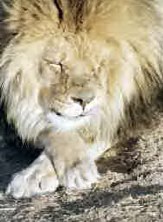THE ACORN TREE

 |
 |
photos courtesy: John Williamson and John Burkitt, Tiger Touch, Fallon, NV (c) 2000
I visited the Tiger Touch site several times and was directed to appropriate sections of the site by the very kind John Williamson, where I learned that Tiger Touch is taking a different and somewhat unique approach towards a solution.
TIGERS TOUCH is a sanctuary and research facility. It was founded in 1997, and is a non profit organization. Their mission is: "To encourage love and respect for wildlife. To kindle the flame of stewardship in others, and to share our knowledge. To offer sanctuary where we can. To fight with a wisdom to preserve what we love. To use the tools that we have to support the pursuit of our key goals: Safety, genetic diversity, and enrichment to the lives of exotic felines, their caretakers, and society." copyright (c) 2001 Tiger Touch (copyrighted (c) 2000.courtesy of John Williamson and John Burkitt, Tiger Touch, Fallon, NV)
Situated on 10 acres in northern Nevada, the Tiger Touch facility does research and maintains a sanctuary that is specially suited for the big cats. The climate is dry and desert like, and their location is remote enough to provide a relaxed and secure environment for the cats.
Their goal is not an easy one. They agree that saving the wildlife from extinction is the goal, but realize the near impossibility of achieving that goal. There is simply no where for the exotic cats to go.
Tiger Touch puts it this way. "The rate at which wild habitat is destroyed by human pressure is alarming, and it is already too late for many species that have become extinct in historic times. It will get worse--much worse--before it gets better." (copyrighted(c)2000 courtesy of John Williamson and John Burkett, Tiger Touch, Fallon NV)
Tiger Touch feels that the best hope for these animals is for them to be allowed to migrate from the shrinking wild areas into the developing areas, and that a cooperative network of responsible, knowledgeable, mini-sanctuaries would help make this work. A simple idea, but one with many problems.
However, they believe; "These issues are mainly political ones. But even under the best conditions, preserving the earth's life web will be a complex task and a monumental challenge to all humanity. It is our passion to be even a small part of the overall solution." (copyrighted(c)2000 courtesy of John Williamson and John Burkett, Tiger Touch, Fallon NV)
At Tiger Touch Sanctuary, they agree that although helping wild populations is important, it's not nearly enough. Parks and zoos should be supported, but the fate of an entire species should not rest on a single solution. Tiger Touch is researching other ways to help with the problem. They believe in people raising and caring for the cats, in order to help preserve the genetic diversity and are working at adapting techniques for rearing and adapting, that are known to reduce the aggression in other species. They found that raising a young cub with these techniques could mean that the adult cat will share a deeper bond and trust with humans.
(copyrighted(c)2000 courtesy of John Williamson and John Burkett, Tiger Touch, Fallon NV)
Tiger Touch says it like this, "Preserving genetic diversity is vital to the survival of threatened and endangered species of felines. Gerald Aquilina, curator of the Buffalo N.Y. Zoo, says 'Numbers are the only thing that are going to support and maintain exotic wildlife.' To get these numbers we must go beyond traditional conservation practices and encourage responsible private stewardship of these creatures. To promote this, we are finding ways to make exotic felines more attractive as companions and more acceptable to potential caretakers and an uncertain public."
(copyrighted(c)2000 courtesy of John Williamson and John Burkett, Tiger Touch, Fallon NV)
Tiger Touch feels it is very important to have responsible, knowledgeable individuals to work together to help the zoos and nature preserves, by supporting mini-sanctuaries. "Without a lot of help from responsible private caretakers, sooner or later there will be calls for drastic, last ditch measures to preserve whatever small gene pools remain until "better" strategies can be developed. By then it may be too late. Such last ditch efforts will result in small, isolated genetic islands without the strength to continue a healthy species. There would be no going back." (copyrighted(c)2000 John Williamson and John Burkett, Tiger Touch, Fallon NV)
Tiger Touch works with the community and experts from around the world so that they may better understand the big cats. Research is their best tool because it helps them to learn more about the animals and that knowledge can be used to help them reach their goal of aiding in preservation by a change in the relationship between the animal and the caretaker.
Obviously, there is a growing need to make everyone aware of the situation that all wildlife faces. When I first began this project, I basically was looking for a topic of discussion. A simple task to gather a little information to share with my visitors. Though it began as a simple task, with a small idea, it has since quickly developed into a long journey, filled with an incredible amount of information.
Gathering this information and compiling it, has made me miss my own self-imposed deadlines for updating my site. However I believe it is well worth it. In addition, it has been the spark that ignited the flame in the heart of THE ACORN TREE.
I am an animal lover, a nature lover, believing that nature is most beautiful in it's own environment, untouched by man. And I still believe that. Visiting these sites, however, I've learned that such a thought is rather idealistic. Learning more about the situation, has opened my eyes to the facts that actually exist. The harsh reality is that human population is expanding rapidly, and that too soon there will be nowhere left for these big cats or other wildlife to exist.
The idea of preserving land for all wildlife is great, but we may be left with pockets of natural environment and wildlife surrounded by developed land and people, forcing a species to become extinct. We can not concentrate our efforts in one area, because we may well overlook the very thing that was needed. And by that time it may be too late for the survival of many species.
We need to follow every road that is available to us; wildlife refuges and sanctuaries, environmental conservation, education, and more. We need to work together using many solutions, not just one, for after all we are striving for the same goal.
Education is the key. Researching and learning everything you can, and than sharing your knowledge. Everyone needs to make it their job to teach one person what they have learned, and that person can teach another and so on.
|
 |
L.A.D.S. (c) copyright 2001

